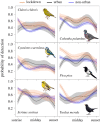Rapid behavioural response of urban birds to COVID-19 lockdown
- PMID: 33715437
- PMCID: PMC7944088
- DOI: 10.1098/rspb.2020.2513
Rapid behavioural response of urban birds to COVID-19 lockdown
Abstract
Biodiversity is threatened by the growth of urban areas. However, it is still poorly understood how animals can cope with and adapt to these rapid and dramatic transformations of natural environments. The COVID-19 pandemic provides us with a unique opportunity to unveil the mechanisms involved in this process. Lockdown measures imposed in most countries are causing an unprecedented reduction of human activities, giving us an experimental setting to assess the effects of our lifestyle on biodiversity. We studied the birds' response to the population lockdown by using more than 126 000 bird records collected by a citizen science project in northeastern Spain. We compared the occurrence and detectability of birds during the spring 2020 lockdown with baseline data from previous years in the same urban areas and dates. We found that birds did not increase their probability of occurrence in urban areas during the lockdown, refuting the hypothesis that nature has recovered its space in human-emptied urban areas. However, we found an increase in bird detectability, especially during early morning, suggesting a rapid change in the birds' daily routines in response to quieter and less crowded cities. Therefore, urban birds show high behavioural plasticity to rapidly adjust to novel environmental conditions, such as those imposed by the COVID-19.
Keywords: behavioural plasticity; citizen science; coronavirus disease; detectability; urban ecology.
Figures



Similar articles
-
Species and habitat specific changes in bird activity in an urban environment during Covid 19 lockdown.Elife. 2024 Feb 9;12:RP88064. doi: 10.7554/eLife.88064. Elife. 2024. PMID: 38335247 Free PMC article.
-
Birds seen and not seen during the COVID-19 pandemic: The impact of lockdown measures on citizen science bird observations.Biol Conserv. 2021 Apr;256:109079. doi: 10.1016/j.biocon.2021.109079. Epub 2021 Mar 27. Biol Conserv. 2021. PMID: 34580546 Free PMC article.
-
Urban wildlife in times of COVID-19: What can we infer from novel carnivore records in urban areas?Sci Total Environ. 2021 Apr 15;765:142713. doi: 10.1016/j.scitotenv.2020.142713. Epub 2020 Oct 3. Sci Total Environ. 2021. PMID: 33077221 Free PMC article.
-
The COVID-19 pandemic: Impacts on cities and major lessons for urban planning, design, and management.Sci Total Environ. 2020 Dec 20;749:142391. doi: 10.1016/j.scitotenv.2020.142391. Epub 2020 Sep 18. Sci Total Environ. 2020. PMID: 33370924 Free PMC article. Review.
-
Inter nation social lockdown versus medical care against COVID-19, a mild environmental insight with special reference to India.Sci Total Environ. 2020 Aug 1;728:138914. doi: 10.1016/j.scitotenv.2020.138914. Epub 2020 Apr 23. Sci Total Environ. 2020. PMID: 32339832 Free PMC article. Review.
Cited by
-
Covid-related surge in global wild bird feeding: Implications for biodiversity and human-nature interaction.PLoS One. 2023 Aug 2;18(8):e0287116. doi: 10.1371/journal.pone.0287116. eCollection 2023. PLoS One. 2023. PMID: 37531331 Free PMC article.
-
As human societies urbanize, so does ecology; taxonomic, geographic, and other research trends in urban vertebrate ecology.Ecol Evol. 2024 May 20;14(5):e11439. doi: 10.1002/ece3.11439. eCollection 2024 May. Ecol Evol. 2024. PMID: 38774138 Free PMC article. Review.
-
Human presence shifts the landscape of fear for a free-living mammal.Ecology. 2025 Jan;106(1):e4499. doi: 10.1002/ecy.4499. Ecology. 2025. PMID: 39800902 Free PMC article.
-
Impact of COVID-19 lockdowns on house sparrows: Comparative study from an Indian context.PLoS One. 2023 Aug 15;18(8):e0289548. doi: 10.1371/journal.pone.0289548. eCollection 2023. PLoS One. 2023. PMID: 37582107 Free PMC article.
-
Hyperbolic discounting underpins response curves of mammalian avoidance behaviour.Biol Lett. 2024 Jul;20(7):20240054. doi: 10.1098/rsbl.2024.0054. Epub 2024 Jul 24. Biol Lett. 2024. PMID: 39046286 Free PMC article.
References
-
- McDonnell MJ, Hahs AK. 2015. Adaptation and adaptedness of organisms to urban environments. Annu. Rev. Ecol. Evol. Syst. 46, 261-280. (10.1146/annurev-ecolsys-112414-054258) - DOI
-
- Sol D, Lapiedra O, González-Lagos C. 2013. Behavioural adjustments for a life in the city. Anim. Behav. 85, 1101-1112. (10.1016/j.anbehav.2013.01.023) - DOI
MeSH terms
LinkOut - more resources
Full Text Sources
Other Literature Sources
Medical

